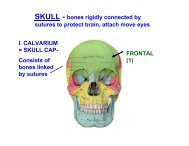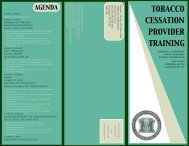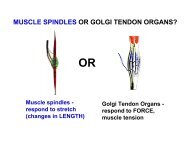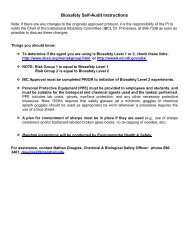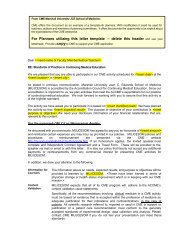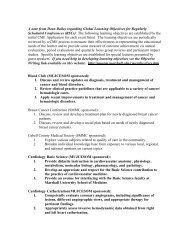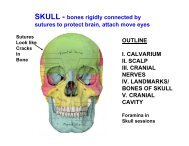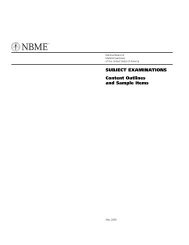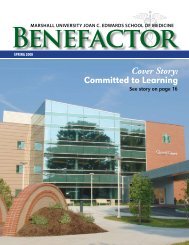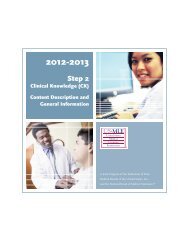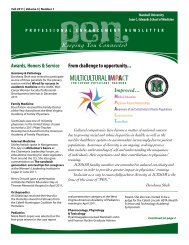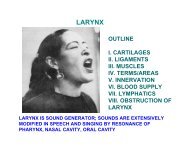FA 5 Progress Report WV-INBRE - Joan C. Edwards School of ...
FA 5 Progress Report WV-INBRE - Joan C. Edwards School of ...
FA 5 Progress Report WV-INBRE - Joan C. Edwards School of ...
- No tags were found...
You also want an ePaper? Increase the reach of your titles
YUMPU automatically turns print PDFs into web optimized ePapers that Google loves.
Program Director/Principal Investigator (Last, First, Middle): Rankin, Gary O 28NGS system and participated in the review <strong>of</strong> NGS pilot grant applications. In order to stay currentwith microarray technology and methods <strong>of</strong> data analysis, core staff members are required toattend workshops or national meetings in their specific areas. Drs. Boskovic, Dr. Fan andPrimerano attended the Association <strong>of</strong> Biomolecular Resource Facilities (ABRF) in February 2011.Drs. Denvir, Boskovic, Fan, Primerano and J.H. Kim will present a poster entitled “Identification <strong>of</strong>Potential Susceptibility Variants for Obesity and Type 2 Diabetes in the TALLYHO Mouse” at theABRF in March 2012.Next Generation Sequencing Pilot GrantsIn Y10 and Y11, the <strong>WV</strong>-<strong>INBRE</strong> program funded six biomedical research pilot grants that requiredthe use <strong>of</strong> next generation sequencing (NGS) technologies as part <strong>of</strong> the experimental design.These technologies include whole genome sequencing, whole exome sequencing, RNA-Seq,Chip-Seq, Methyl-Seq, microbiome studies and related high throughput methods. The primarypurpose <strong>of</strong> these awards was to allow investigators to gather preliminary data forinvestigator-initiated grant applications in the biomedical sciences. This solicitation for applicationswas open to applications from investigators at West Virginia University, Marshall University and <strong>WV</strong>undergraduate institutions that are part <strong>of</strong> the <strong>WV</strong>-<strong>INBRE</strong> network. Funds ($12,000 per awardee)were used for the acquisition <strong>of</strong> NGS supplies or services. NGS data from two <strong>of</strong> the six projects(#1 and #4) has been analyzed and will be presented at conferences in March 2012. Data fromprojects #2 and #5 is being analyzed at present. The following sections describe the progress <strong>of</strong>each <strong>of</strong> the six pilot projects. A table showing protections against risks for each project is given inthe Appendix materials.NGS Project #1TitleOral Health Disparities Among Elders With and Without Cognitive Impairment: Microbiome AnalysisSubproject investigator. Chris Cuff PhDIntroductionAn ongoing, multi-Institution, interdisciplinary research project at West Virginia University and DukeUniversity is investigating the link between oral health and mental function in older citizens <strong>of</strong> WestVirginia in an NIH-sponsored study. As part <strong>of</strong> this study, we are performing microbiome analysis<strong>of</strong> oral sub-gingival plaque samples by high throughput DNA sequencing. The goal <strong>of</strong> this work is todetermine risk factors linking oral health and cognitive impairment.Hypothesis/Specific AimIt is our hypothesis that microbial community composition influences the severity <strong>of</strong> oral disease,which plays a role in cognitive impairment, including development <strong>of</strong> Alzheimer’s disease. TheSpecific Aim <strong>of</strong> this study is to perform molecular identification <strong>of</strong> bacterial phylotypes in subgingivalplaque samples from participants in clinical research aimed at addressing the role <strong>of</strong> oral health incognitive impairment.MethodsTwenty-two subgingival plaque samples from clinically healthy and diseased periodontal sites wereobtained from study participants as part <strong>of</strong> their oral evaluations following informed consent. Fromeach participant, multiple plaque samples (2-6) from several sites were obtained and pooled into‘healthy’ and ‘diseased’ sites based on clinical evaluation and pocket probing depths <strong>of</strong> 5mm. DNAwas isolated from these samples using commercially available kits, and PCR amplification <strong>of</strong> aportion <strong>of</strong> the gene encoding the 16S rRNA subunit was accomplished using the method <strong>of</strong>Bartram et al. (Appl. Environ. Microbiol. 2011 June; 77(11): 3846–3852). PCR products weresequenced in 2 flow cells by the Marshall University Genomics Core Facility. Resulting sequencesare being analyzed using Quantitative Insights into Microbial Ecology (QIIME) computer programPHS 2590 (Rev. 06/09)Continuation Format Page



